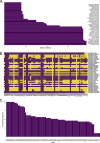Plastome phylogenomics of the diverse neotropical orchid genus Lepanthes with emphasis on subgenus Marsipanthes (Pleurothallidinae: Orchidaceae)
- PMID: 40775299
- PMCID: PMC12329981
- DOI: 10.1186/s12862-025-02396-6
Plastome phylogenomics of the diverse neotropical orchid genus Lepanthes with emphasis on subgenus Marsipanthes (Pleurothallidinae: Orchidaceae)
Abstract
Well-resolved phylogenetic relationships within the diverse Neotropical orchid genus Lepanthes are presented based on a genome skimming approach that yielded nine newly sequenced chloroplast genomes. We complemented this with 17-86 plastome coding genes for 26 species retrieved from GenBank, alongside amplified matK and rITS regions. The Lepanthes plastomes (157,185-158,260 bp, 37.15% GC content) contained 136 annotated genes, including 86 protein-coding, 42 tRNA, and 8 rRNA genes. We identified six hypervariable regions, including parts of the ycf1 gene, as potential DNA barcodes. Phylogenetic analyses revealed that Carl Luer's subgeneric classifications are non-monophyletic, a finding confirmed by PCA of continuous morphological traits, reflecting significant morphological homoplasy. Six major clades were identified, though resolution for the phylogenetic backbone remains unresolved at two nodes. Subgenus Marsipanthes is not monophyletic as currently circumscribed, with two subclades recovered in distinct positions within the phylogeny. An early-diverging lineage, comprising species restricted to the eastern Andean slopes from southern Colombia to Peru, includes members of both Marsipanthes and Lepanthes. A derived clade, consisting of species from both subgenera, confined to the Chocó biogeographic region, forms an unresolved polytomy. Although only a subset of Lepanthes diversity was sampled, this study captures significant taxonomic, geographic, and morphological variation. It provides foundational insights into the genu's evolutionary history, along with tools and hypotheses that can be expanded upon in future research to further refine our understanding of its biogeographic history.
Keywords: Ycf1; Andes; Chloroplast; Chocó Biogeographic Region; Colombia; Eastern Andes; Ecuador.
© 2025. The Author(s).
Conflict of interest statement
Declarations. Ethics approval and consent to participate: Not applicable. Consent for publication: Not applicable. Competing interests: The authors declare no competing interests.
Figures







References
-
- Karremans AP. Genera Pleurothallidinarum: an updated phylogenetic overview of Pleurothallidinae. Lankesteriana. 2016;16(2):219–41. 10.15517/lank.v16i2.26008.
-
- Luer CA, Thoerle L. Icones Pleurothallidinarum XXXI: lepanthes of Bolivia. Monogr Syst Bot Missouri Bot Garden. 2010;120:1–64.
-
- Bogarín D, Cinchilla IF, Cedeno-Fonseca M. Two new species of Lepanthes (Orchidaceae: Pleurothallidinae) from Costa Rica and their phylogenetic affinity. Plant Syst Evol. 2020;20(306):1–13. 10.1007/s00606-020-01653-z.
-
- POWO. Plants of the World Online. Facilitated by the Royal Botanic Gardens, Kew. 2024. Published on the Internet; https://powo.science.kew.org/Retrieved 02 Dec 2024.
-
- Bogarín D, Jiménez D. Lepanthes novae Durikaensis. Orchids. 2015;84:430–40.
MeSH terms
LinkOut - more resources
Full Text Sources
Miscellaneous
